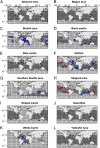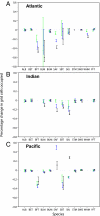Range contraction in large pelagic predators
- PMID: 21693644
- PMCID: PMC3141942
- DOI: 10.1073/pnas.1102353108
Range contraction in large pelagic predators
Abstract
Large reductions in the abundance of exploited land predators have led to significant range contractions for those species. This pattern can be formalized as the range-abundance relationship, a general macroecological pattern that has important implications for the conservation of threatened species. Here we ask whether similar responses may have occurred in highly mobile pelagic predators, specifically 13 species of tuna and billfish. We analyzed two multidecadal global data sets on the spatial distribution of catches and fishing effort targeting these species and compared these with available abundance time series from stock assessments. We calculated the effort needed to reliably detect the presence of a species and then computed observed range sizes in each decade from 1960 to 2000. Results suggest significant range contractions in 9 of the 13 species considered here (between 2% and 46% loss of observed range) and significant range expansions in two species (11-29% increase). Species that have undergone the largest declines in abundance and are of particular conservation concern tended to show the largest range contractions. These include all three species of bluefin tuna and several marlin species. In contrast, skipjack tuna, which may have increased its abundance in the Pacific, has also expanded its range size. These results mirror patterns described for many land predators, despite considerable differences in habitat, mobility, and dispersal, and imply ecological extirpation of heavily exploited species across parts of their range.
Conflict of interest statement
The authors declare no conflict of interest.
Figures




Comment in
-
Changes in ranges of large ocean fish.Proc Natl Acad Sci U S A. 2011 Jul 19;108(29):11735-6. doi: 10.1073/pnas.1109139108. Epub 2011 Jul 6. Proc Natl Acad Sci U S A. 2011. PMID: 21734153 Free PMC article. No abstract available.
References
-
- Myers RA, Worm B. Rapid worldwide depletion of predatory fish communities. Nature. 2003;423:280–283. - PubMed
-
- Sibert J, Hampton J, Kleiber P, Maunder M. Biomass, size, and trophic status of top predators in the Pacific Ocean. Science. 2006;314:1773–1776. - PubMed
-
- Ferretti F, Worm B, Britten GL, Heithaus MR, Lotze HK. Patterns and ecosystem consequences of shark declines in the ocean. Ecol Lett. 2010;13:1055–1071. - PubMed
-
- Brown JH, Stevens GC, Kaufman DM. The geographic range: Size, shape, boundaries, and internal structure. Annu Rev Ecol Syst. 1996;27:597–623.
-
- Laliberte AS, Ripple WJ. Range contractions of North American carnivores and ungulates. Bioscience. 2004;54:123–138.
Publication types
MeSH terms
LinkOut - more resources
Full Text Sources

